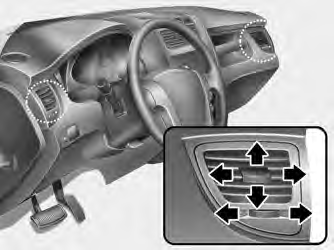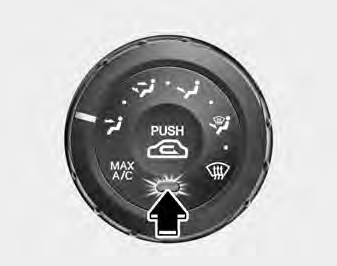 Kia Sportage: Manual climate control system
Kia Sportage: Manual climate control system
 1. Fan speed control
knob 2. Mode selection knob 3. Temperature control knob 4. Air conditioning button
(if equipped) 5. Air intake control button 6. Rear window defroster button (if equipped)
1. Fan speed control
knob 2. Mode selection knob 3. Temperature control knob 4. Air conditioning button
(if equipped) 5. Air intake control button 6. Rear window defroster button (if equipped)

Fan speed control knob The ignition switch must be in the ON position for fan operation. The fan speed control knob allows you to control the fan speed of the air flowing from the ventilation system. To change the fan speed, turn the knob to the right for higher speed or left for lower speed. Setting the mode selection knob to the “0” position turns off the fan.

Temperature control knob The temperature control knob allows you to control the temperature of the air flowing from the ventilation system. To change the air temperature in the passenger compartment, turn the knob to the right for warm and hot air or left for cooler air.

Mode selection knob The mode selection knob controls the direction of the air flow through the ventilation system. The steps (•) between the air flow positions adjust the direction of the air flow to the middle position.

MAX/ A/C position When you select the MAX A/C mode while the fan speed is on, the following system settings will be made automatically; • the air conditioning system will be turned on. • the recirculated air position will be selected. • the face mode will be selected. If you select MAX A/C mode, you will not be able to cancel the A/C system operation, or change the recirculated air mode position. Set the fan speed control knob to the desired speed and rotate the temperature control knob to the extreme left position for maximum cooling. (outlet port: , ) Face position Air flow is directed toward the upper body and face. Additionally, each outlet can be controlled to direct the air discharged from the outlet. (outlet port: , ) Face - floor position Air flow is directed towards the face and the floor. The air to the floor is warmer than the air to the face (except when the temperature control is set to the extreme cold position). (outlet port: , , , ) OFF position The climate control system is turned off. Floor position Most of the air flow is directed to the floor, with a small amount of the air being directed to the windshield and side window defroster. (outlet port: , , , , ) Floor - defrost position Most of the air flow is directed to the floor and the windshield with a small amount directed to the side window defrosters. (outlet port: , , , , ) Defrost position Most of the air flow is directed to the windshield with a small amount of air directed to the side window defrosters. (outlet port: , , )

Instrument panel vents If air flow control is not satisfactory, check the instrument panel vents. The outlet port ( ) can be opened or closed separately using the horizontal thumbwheel. To close the vent, rotate it left to the maximum position. To open the vent, rotate it right to the desired position. Also, you can adjust the direction of air delivery from these vents using the vent control lever as shown.

Air intake control button This is used to select outside (fresh) air position or recirculated air position. To change the air intake control position, push the control button. Recirculated air position The indicator light on the button is illuminated when the recirculated air position is selected. With the recirculated air position selected, air from passenger compartment will be drawn through the heating system and heated or cooled according to the function selected. Outside (fresh) air position The indicator light on the button is not illuminated when the outside (fresh) air position is selected. With the outside (fresh) air position selected, air enters the vehicle from outside and is heated or cooled according to the function selected. It should be noted that prolonged operation of the heating in recirculated air position will cause fogging of the windshield and side windows and the air within the passenger compartment will become stale. In addition, prolonged use of the air conditioning with the “recirculated air position” selected, will result in excessively dry air in the passenger compartment.
WARNING - Recirculated air • Continued climate control system operation in the recirculated air position may allow humidity to increase inside vehicle which may fog the glass and obscure visibility. • Continued climate control system operation in the recirculated air position can result in somewhat reduced oxygen levels, causing drowsiness or sleepiness, and loss of vehicle control. Set the air intake control to the outside (fresh) air position as much as possible while driving.

Air conditioning button (if equipped) Push the A/C button to turn the air conditioning system on (indicator light will illuminate). Push the button again to turn the air conditioning system off. System operation Ventilation 1. Set the mode to the position. 2. Set the air intake control to the outside (fresh) air position. 3. Set the temperature control to the desired position. 4. Set the fan speed control to the desired speed. Heating 1. Set the mode to the position. 2. Set the air intake control to the outside (fresh) air position. 3. Set the temperature control to the desired position. 4. Set the fan speed control to the desired speed. 5. If dehumidified heating is desired, turn the air conditioning system (if equipped) on. • If cool air is desired at face level for bi-level operation, set the mode to the position. • If the windshield fogs up, set the mode to the , position. Air conditioning (if equipped) All Kia Air Conditioning Systems are filled with environmentally friendly R-134a refrigerant which is not damaging to the ozone layer. 1. Start the engine. Push the air conditioning button. 2. Set the mode to the position. 3. Set the air intake control to the outside air or recirculated air position. 4. Set the temperature control knob to the desired position. 5. Set the fan speed control to the desired speed. 6. Adjust the fan speed control and temperature control to maintain maximum comfort. • If warmer air is desired at floor level for bi-level operation, set the mode to the position and adjust the temperature control to maintain maximum comfort. • When maximum cooling is desired, set the temperature control to the extreme left position, set the air intake control to the recirculated air position, then set the fan speed control to the highest speed.
NOTICE • When using the air conditioning system, monitor the temperature gauge closely while driving up hills or in heavy traffic when outside temperatures are high. Air conditioning system operation may cause engine overheating. Continue to use the blower fan but turn the air conditioning system off if the temperature gauge indicates engine overheating. • When opening the windows in humid weather air conditioning may create water droplets inside the vehicle. Since excessive water droplets may cause damage to electrical equipment, air conditioning should only be run with the windows closed.
Air conditioning system operation tips • If the vehicle has been parked in direct sunlight during hot weather, open the windows for a short time to let the hot air inside the vehicle escape. • To help reduce moisture inside of windows on rainy humid days, decrease the humidity inside the vehicle by operating the air conditioning system. • During air conditioning system operation, you may occasionally notice a slight change in engine speed at idle as the air conditioning compressor cycles on. This is a normal system operation characteristics. • Use the air conditioning system every month if only for a few minutes to ensure maximum system performance. • When using the air conditioning system, you may notice clear water dripping (or even pudding) on the ground under the passenger side of the vehicle. This is a normal system operation characteristics. • The air conditioning system includes a function that automatically turns the air conditioning compressor off if engine coolant temperature approaches an over heating level. The air conditioning compressor operation will resume once engine coolant temperature returns to the normal range. Also, the air conditioning compressor is automatically turned off for a few seconds when the accelerator is fully depressed (wide open throttle). • When operating the air conditioning system use the outside (fresh) air position. • Operating the air conditioning system in the recirculated air position does provide maximum cooling, however, continual operation in this mode may cause the air inside the vehicle to become stale. Checking the amount of air conditioner refrigerant and compressor lubricant When the amount of refrigerant is low, the performance of the air conditioning is reduced. Overfilling also has a bad influence on the air conditioning system. Therefore, if abnormal operation is found, have the system inspected by an authorized Kia dealer.
CAUTION The air conditioner refrigerant container is highly pressurized. Therefore it should be serviced by an authorized Kia dealer. Improper service may cause serious injury.
NOTICE When the performance of the air conditioning system is reduced it is important that the correct type and amount of oil and refrigerant is used. Otherwise, damage to the compressor and abnormal system operation may occur.
 Hazard warning flasher
Hazard warning flasher
The hazard warning flasher causes the rear tail lights and front turn signal
lights to flash on and off, which serves as a warning to other drivers to exercise
caution when approaching or passin ...
 Automatic climate control system
Automatic climate control system
1. Temperature control
knob 2. A/C display 3. Fan speed control knob 4. AUTO (automatic control) button
5. Mode selection button 6. Air conditioning button 7. Front windshield defrost
button 8. ...
See also:
LATCH lower anchor
Failure to follow the warnings and
instructions for proper use and installation
of child restraints could result in
serious injury or death of a child or
other passengers in a sudden stop or ...
Repairing minor paint damage
Regularly inspect the paintwork for damage.
Any stone chips, fractures, or deep scratches,
in the paint/bodywork should be repaired
promptly. Bare metal will corrode quickly, and
if left untreated ...
DVD Distortion
Video distortion can occur when operating cellular phones, scanners, CB radios,
Global Positioning Systems (GPS)*, two-way radios, mobile faxes, or walkie talkies.
It might be necessary to turn off ...
